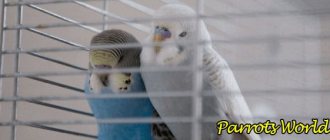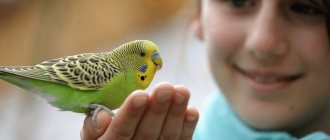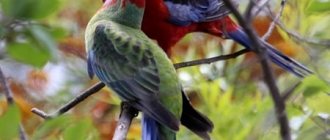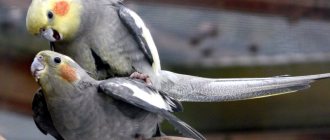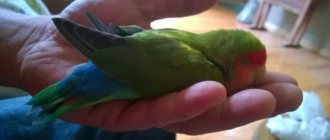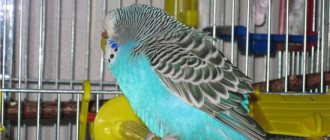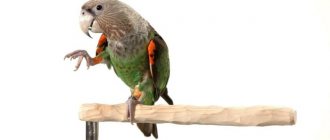Birds spend a significant part of their day in a state of sleep. The approximate time they spend sleeping is 10 - 14 hours. Much also depends on the season. In this article you will learn how budgies sleep in a cage at night and during the day. We will also look at difficulties that may arise with sleep. We will also tell you how to act in each specific case.
How do they sleep
The bird chooses the place and pose independently, which depends on the characteristic features of the pet.
If nothing is bothering the pet, the individual sits on a perch, with the young birds clinging to the bars of the cage with one paw. In the presence of a stranger and animals in the room, they sleep in the lower part of the cage, or under the “roof”. If a bird hides its head under its wing and crests, this indicates that the pet is freezing. If the pet sleeps all the time, it experiences a stressful situation, this often happens when there is a change of owners or a new environment. Prolonged sleep accompanied by ruffling of feathers indicates a painful condition of the pet.
Features of sleep of budgies
The genetics of these birds takes its toll. Having become accustomed to resting at noon in their historical homeland, they retained this habit in the vastness of our country, at home. Therefore, wavy birds like to take a nap at lunchtime, sitting on a perch and relaxing a little. This is an absolutely normal phenomenon for budgies, and there is no need to worry that the bird is sick, there is something wrong with it.
Daytime sleep in apartment mode can last half an hour or an hour. The bird dozes during the day when the house is noisy and light. But at night, for proper sleep, budgies need complete peace, the absence of flickering light, irritating noise sounds and music. All of the above are alarming factors for the wavy. It’s simply impossible to get a good night’s sleep in such conditions. The owner may be accustomed to such conditions of night rest, but the bird will not be able to get used to it, and then will sleep all day.
How long do domestic wavy cats sleep? For proper rest, they need at least 10 hours a day. If your male or female is very energetic, then they will sleep longer. This is the only way their body can rest and develop fully.
Sleep is an important aspect of maintaining health. Therefore, budgerigars can suffer greatly from a disrupted schedule, even to the point of stress. Health problems due to poor sleep may manifest themselves more quickly in parrots than in humans. And in order to prevent this, you simply need to take care of the bird, cover its cage with a blanket if you need to sit in the light at night.
When you cover a bird's house, don't forget that it still needs oxygen, so it shouldn't sleep like that all night.
If, while observing your budgie, you find that it sleeps all night and is inactive during the day, often dozing, it means that it is most likely sick. If you notice that the bird sleeps almost all the time, do not let the situation take its course. Examine the bird carefully and consult a specialist. It is possible that your flying friend is infected with parasites. They become active in the dark and do not allow the bird to fully rest and stay awake. Take care of your feathered friend, be attentive to him.
If your parrot sleeps a lot
If a budgie sleeps all the time, this is an alarming sign. First of all, severe exhaustion, both mental and physical. For example, after an influx of guests and excessive attention, parrots may well sleep for several days, only occasionally waking up to eat.
On a regular basis, this can only happen in case of health problems. The best solution would be to create all the necessary conditions for your pet to sleep properly. And if there is no improvement, contact a veterinarian.
Daytime naps are the norm
Ornithologists claim that daytime sleep is the norm and is natural for parrots. They are very active and lively in the morning. Peak activity occurs between 10 and 12 hours. Then they sleep, sitting in a cage on a perch, and in the evening, around 16-17, they are again ready for communication and entertainment. This mode, in principle, is convenient for the owners. During the day they are usually away from home, and in the evening the whole family gathers. A well-rested and rested pet by this time pleases and entertains all household members. Based on this feature, it is recommended to choose morning or evening hours for training with a parrot, when he has rested and slept well. There will be more benefit from such activities.
Parrots also sleep during the day in the wild. They come from warm, hot countries, where the maximum heat occurs in the middle of the day. At this time, the entire flock of parrots hides in the treetops and sleeps, which is very reasonable. As the heat subsides, they are active and active again. Therefore, parrots simply need daytime sleep. Some experts believe that it is as important as the night one. Birds must get enough sleep, otherwise they will get sick. Budgerigars, for example, sleep for 10 hours, and this is normal. They need to create conditions for daytime sleep.
By sleeping during the day, the bird can compensate for lack of sleep at night. After all, very often the owners do not turn off the TV until late at night, and early in the morning the light turned on or the radio turned on wakes up the parrot. Sometimes owners behave very indelicately with their pets. Here is the poor bird during the day and fills the gap in night sleep. Let us repeat once again that the norm for parrots is at least 10 hours of sleep.
How to create conditions for sleep
To ensure that nothing interferes with the parrot’s sleep, the owner must organize appropriate conditions. It is unacceptable to rudely disturb the bird's peace at night: turn on the overhead lights, slam the door, turn up the volume of the TV. If a bird dozes off during the day, it also needs silence.
On a note! Monotonous weak sounds will not disturb the wavy when he is dozing. Parrots have ears covered with feathers. Birds can distract themselves from intrusive noise by pressing their feathers against their ear canals.
Breeders take special care of young birds: they remove the perches at night to prevent them from falling from a height. If the chick falls fast asleep on a stick and loses its balance, it may fall and become very frightened, or even injured. An alternative to a perch is a small raised platform made of cardboard on which the parrot can safely perch.
With the onset of darkness, the parrot instinctively begins to fall asleep. If you need light in the room, and the parrot's activity period is running out, cover the cage with thick fabric. A woolen scarf or blanket will do. Leave a small gap for air circulation. Having accustomed your pet to this method, you can independently regulate its regime.
Budgerigars sleep a lot, sometimes in unimaginable positions. If there is not enough sleep at night, they make up for this lack with daytime rest. The owner and his family members are required to have compassion and respect for this peculiarity of pets. A well-rested bird will fill the house with cheerful chirping and will evoke only positive emotions in people.
Deviations from the norm
Sleep during the day
It was previously mentioned that budgies like to rest during the day. So don't worry if your pet sleeps during the daytime. The bird probably had a hearty meal recently. Or she got bored and therefore fell asleep.
If your budgie sleeps a lot at night and at the same time tends to sleep during the day, then this is a cause for concern. In this situation, you should carefully monitor your pet. Poor appetite (or refusal to eat) and a cage tray strewn with fluff most likely indicate the beginning of seasonal molting. Read about what molting is and how to act during molting here.
A sloppy appearance, nausea, and problems with bowel movements may be signs of poisoning or the initial stage of a serious illness. In such a situation, the best solution is to consult a veterinarian.
Sleep at night
It’s bad if the room is quiet and dark, it’s night outside, and the bird is not sleeping. At the same time, she can even fly in a cage and make strange sounds. There are several reasons why budgies do not sleep at night:
- bruise (fracture);
- fear of something;
- parasites.
If this happens to your feathered pet, inspect it carefully. Check to see if he is hurt or has a fracture. Maybe he fell from a perch or something and got hurt. In such a situation, disinfect the wound. In case of a fracture, a splint must be applied.
The second possible situation: there are no wounds on the parrot’s body. At the same time, he continues to behave restlessly and does not fall asleep. Then perhaps the bird is afraid of something. Budgerigars can become frightened under a variety of circumstances. The cause of fear may be banal shadows on indoor objects, or other pets. It is advised to close doors in rooms where budgies sleep. Then, most likely, no one and nothing will be able to disturb their peace.
If the bird still continues to fuss and squeak, then it may have parasites. Seek advice from specialists. Ask them to examine your pet. Tell them about your concerns about your pet's health and behavior. Especially if you yourself could not understand what is bothering your bird and how to help it.
Is the sleep of wavy animals disturbed?
Although birds easily regulate their regime on their own, sometimes owners note its violation.
Therefore, the following nuances are taken into account:
- The pet begins to sleep during the day. Some birds rarely sleep during the day, but owners notice that the bird changes its schedule, so it prefers to sleep for several hours during the day. Such a change in regime should not worry humans, since under natural conditions birds sleep during the day. This is usually due to waste of energy or boredom. Parrots often fall asleep after eating well. This behavior allows you to pass the time or gain strength.
- The bird sleeps well at night, but is constantly lethargic during the day. Such changes should excite the owner, as the pet needs to be carefully monitored. If his appetite worsens and feathers fall out, this indicates seasonal molting. It is advisable to introduce vitamins and minerals into the bird's diet. If the condition worsens, and the bird has a disheveled appearance, it is recommended to consult a veterinarian. Poisoning or seasonal illnesses are additionally accompanied by diarrhea and vomiting.
- The parrot doesn't sleep at night. This behavior is considered a bad sign. At night, the bird can fly around the cage, scream or run along the twigs, even in pitch darkness. Initially, you need to make sure that the bird is not hurt or has a broken wing or leg. Detected wounds are treated with disinfectants, and if a fracture is detected, a splint will have to be applied. If there are no health problems, then this behavior indicates that the wavy is frightened. He may be afraid of strangers, pets, or loud noises. Therefore, it is necessary to create conditions under which the wavy can calm down. To do this, you need to close the door, create twilight and calmly talk to your pet.
A good owner will always notice any changes in the pet’s behavior, so he can promptly improve the health or calm the bird.
Is it possible to wake me up?
Sometimes, on the contrary, a parrot needs to be woken up rather than put to sleep. For example, the pet settled into its usual half-hour nap during the day, but the owner planned a trip to the veterinarian. As already noted, the bird should feel safe while sleeping, and therefore you should not suddenly wake up the parrot with loud sounds. A pet that is awakened by sudden loud music while sleeping will have a panic attack, which can even cause cardiac arrest. If such a terrible outcome does not follow, then the abruptly awakened bird will become nervous and fearful for a long time; for several days it will not sleep fully and may lose trust in its owner.
Tips on parrots' sleep patterns are in the next video.
Cold
The respiratory system of a parrot is special. Therefore, drafts and sudden changes in temperature have a negative effect on the body.
Symptoms:
- loss of activity (the bird practically does not tweet);
- increased drowsiness;
- ruffled appearance;
- rapid breathing, sometimes accompanied by twitching of the tail to the beat;
- refusal to drink and eat;
- inflammation of the mucous membrane, the appearance of discharge from the sinuses.
Often a cold leads to pneumonia. Wheezing and wheezing appear. To identify signs, you should carefully take the bird in your hand (preferably in a dark place, this will eliminate the appearance of stress and random movement around the cage), using a phonendoscope, listen to the work of the lungs as you inhale and exhale. Diagnosis is carried out for the presence of extraneous sounds. If you don’t have such a medical device, you can put your ear to the surface of your pet’s back.
Natural and home conditions
Budgerigars are native to Australia. Under natural conditions, these birds have a lot to do: feed themselves and their offspring, find drinking water, and so on. To survive, parrots have to cross long distances, so they need a lot of strength. Sleeping at night helps you accumulate energy for future flights.
In addition, the Australian mainland has a unique climate - hot and humid. By the middle of the day, the air temperature rises so much that the parrots have to hide in the shade of trees, which also save them from attacks by predators. Parrots also spend the hot daytime time resting and gaining strength.
Domesticated parrots have the same natural instincts. If you see your pet sleeping during the day, don't worry - this habit is in their blood. However, in the wild, nature takes control of parrots’ sleep. Their owners should take care of how to sleep budgies at home.
How to properly water birds
A parrot should always have access to water. Some people mistakenly believe that the water needs to be changed as soon as it runs out in the drinking bowl. But the latter can be designed for several liters. The liquid that has settled in a closed container is filled with harmful microelements. Therefore, the water should be changed daily.
In the hot summer months, the liquid needs to be renewed twice a day. For budgies, ordinary tap water or boiled water is not suitable. Neither the first nor the second contains the minerals necessary for poultry. The best option is industrial bottled solutions without gas, enriched with potassium, magnesium and sodium.
Parrots can also prepare juices: manually from fruits and vegetables, taking into account the above lists. Those products that are sold in regular grocery stores are not suitable because they contain a high percentage of sugar. As an alternative to hand-squeezing, you can use store-bought juices for young children.
Alone or in pairs - which is better?
The budgerigar is a flocking bird that cannot develop adequately without its relatives nearby.
Of course, the bird will greet its owner more joyfully and learn to speak faster, but this is all the result of sadness and sadness in moments of human absence.
Despite the seemingly external satisfaction from life and a cheerful mood, a lonely parrot will not receive what is inherent in it by nature. Even if you spend 24/7 with your pet, this is not enough, because... Bird communication is not just about actual presence or voice. This is also communication with body language, gestures, plumage, coloring.
In animals of the same species, even if there are only two of them, a certain hierarchical behavior is established: one of the parrots becomes a role model. In addition, in pairs, parrots can engage in procedures laid down by genes. This is something that cannot only be taught, but also unlearned.
As the owners of several birds say, monitoring and caring for a pair is much easier than for a single bird, because... in a group, parrots can occupy themselves and will not constantly call their owner across the entire apartment.
How many parrots do you have?
12
How to care for a parrot
Careful care and attention from the owners will help pet parrots to quietly endure the beginning of molting. Considering that during this delicate period, the immunity of feathered pets is significantly reduced, it is necessary to take a number of measures that will protect them from aggressive environmental influences and disease. Such preventive measures include:
- proper balanced nutrition, which will include a high content of beneficial vitamins and minerals;
- organization of walking - free flight around the apartment;
- water procedures;
- control of temperature and humidity in the room where the poultry is kept.
Nutrition during the molting period
During molting, the parrot needs to be fed better, since colossal reserves are spent on the growth of new plumage, and restoring their balance in the body is vital.
| Foods that must be included in the diet of a budgerigar are mandatory. | |||||
| Cereals; Seeds; Nuts; Sesame; | Fruits and berries, dried fruits from them | Vegetables | Greenery | Fermented milk feed | Animal feed |
| Canary seed; Meadow grass seeds; Bran, Special grain premixes “for shedding”. | Apples; Pears; Peaches; Bananas; Citrus; Melons; Cherries; Cherries; Apricots; Raspberries; Blackberry; Strawberry; Blueberry; Cowberry; Grape; Currant. | Carrot; Pumpkin; Zucchini; Cabbage; Cucumbers; Patissons. | Sprouted wheat and oats; Spinach; Dandelion; Plantain; Nettle; Carrot and beet tops; Celery; Chickweed; woodlouse; Shepherd's Purse; Tree branches. | Skimmed milk; Low-fat cottage cheese. | Mealworms; Bloodworm; Drosophila; Grasshoppers; May beetles; Eggs of chickens and quails. |
Vitamins and minerals
During the period of plumage change, the parrot's diet should contain the following minerals:
- meat and bone meal;
- calcium glycerophosphate;
- chalk;
- sand;
- sepia;
- feed sulfur;
- egg shells;
- crushed shells;
- crushed cuttlefish shell.
Preparations with a complex of vitamins are allowed to be given after the parrot is one year old.
Veterinarians recommend that during molting you pay attention to such vitamin mixtures as VitaCraft, VitaSol 8 in 1 UltraWhite, BifarMauser Trofen, BifarVinka, brewer's yeast with the addition of feed sulfur
Parrot bathing
In addition to the fact that there should always be drinking water in the parrot’s cage, he needs to have “bath” days. Budgerigars love to splash around in the water, and during the molting period such procedures are especially recommended, since bathing helps to quickly get rid of old feathers, relieve itching, and improve their mood. Wild parrots bathe in the rain or look for morning dew on tree leaves to “wash themselves.”
To bathe your pet budgie, you can simply turn on the tap and let your pet out of the cage for a walk under such a “shower”. You can use a small container the size of a soup plate, pour water at room temperature into it, and place the container in the bird’s cage. Sometimes there are individuals with a special disposition who do not really like the prospect of being a little “damaged.” They can simply be sprayed with water from a water gun or spray bottle.
Air humidity
As you know, the birthplace of budgerigars is tropical and equatorial regions with high humidity. Therefore, when breeding these birds at home, they need to recreate conditions as close to natural as possible.
The most favorable temperature range is +20C-+25C.
But the most important thing is to maintain humidity in the apartment - it should be more than 60%. With these parameters, the parrot will feel comfortable, and the molting period will pass quickly and painlessly.
How long do budgies sleep?
Most people who have such a small pet in their home are interested in how long a budgie should sleep. This interest is due to the fact that such birds spend a lot of time sleeping. In this regard, owners are concerned about the health of their pets. After all, maybe it’s not normal for a bird to sleep so much.
If your budgie is constantly sleeping, there is no need to panic and ring the bells
This is due to the fact that sleep occupies a fairly important place in the life of birds. Budgerigars are significantly different from some birds, which can sleep for several hours and still feel quite fine and energetic.
For proper sleep, wavy birds need about 10 hours, and sometimes more.
Reasons why a budgie sleeps all the time
The historical homeland of budgerigars is Australia. It was from this country that these cute birds began to be supplied to the domestic market. In its natural habitat, a small bird has quite a lot to worry about. After all, how much work it costs to get food in order to feed yourself and your offspring, and at the same time it is worth remembering about the enemies of birds, of which there are quite a lot.
But despite such a busy schedule, wavy finds time to take a nap. Daytime naps are explained by the fact that in Australia there are times during the day when the heat is unbearable. During this period, all birds hide in the shade of trees. The parrot is no exception and spends several hours in the middle of the day on a tree branch. What else can you do on a tree if not doze off? This was precisely the reason for the pet’s daily nap.
Therefore, if your bird goes to sleep during the day, it’s okay. This parrot naturally sleeps a lot, and there is nothing unusual about it.
How does a budgie sleep?
Another unique feature of a budgie's sleep is the position in which it sleeps. Basically, an adult bird sleeps on twigs. At the same time, she is in a standing position on one leg. It is not known exactly why on one leg. Most people only joke that it is simply difficult for them to sleep on two legs, since they are very tired during the day and it is difficult for them to stand on two legs.
But, it should be noted that not all pets sleep in this position. There are individuals that doze on two legs. This is especially true for young individuals who do not yet have very good coordination. Therefore, it is very dangerous for them to sleep on one leg, as they can fall out of the tree.
Also, most owners of such pets have noticed one strange feature, which is associated with the fact that during sleep the parrot hides its beak in its plumage. At the same time, he turns his head behind his back. This behavior is quite easy to explain. The fact is that in this position the parrot feels more comfortable and safe. This fact has long been proven by many scientists.
The bottom line is that if there is a curtain on the window, then the chance that the bird will get sick is minimal. But not everyone knows this, which is why sometimes there are no curtains. In this regard, the parrot makes its own curtain, which consists of its fluff. Also, thanks to this position, the parrot retains its body heat very well, which allows it not to freeze at night.
Compatibility of human and parrot diurnal patterns
If everything is clear with how budgies sleep, then with the duration of sleep the situation is different. After all, in order for a bird to feel good, it needs to get a good night's sleep. In this regard, control how much your budgie sleeps.
But the difficulty is that the daily routine of humans and the daily routine of birds are significantly different. And it is difficult to ensure sufficient sleep here. In order not to change your routine and not harm your pet, you can use the option with a blanket. The method works quite simply. When you cover the cage with a blanket, the parrot associates it with sleep and begins to doze off. But in order to achieve such an effect, you need to spend more than one day. But the result is worth it.
Why and what to do if your budgie is
Sleeps all day
The bird stays in the kingdom of Morpheus during the day not only because of illness. A parrot may not get enough sleep if its routine and that of its owner do not match, or something regularly interferes with its calm at night.
It is necessary to pay attention to how and when the pet eats and count how many hours per day he sleeps. It is good to examine the bird, pay attention to its droppings and the condition of the breathing holes. If there are no signs of disease, then it is necessary to adjust the living conditions, review the diet and ensure the correct day and night cycle for the bird.
How does Jaco SLEEP? Roma went to bed late! — Season 2, episode 25
Doesn't sleep at night
If the parrot does not rest at night, then the reason is fear. Placing the cage near a window can help with this. Car headlights, lights turning on in the house opposite, noise from an open window - all this frightens the bird. Plastic perches can also become a problem, since the feathered pet falls off them in a dream and gets scared, and can also be hit hard or even injured. It is necessary to find a more appropriate place in the house for the parrot to live, and replace all the plastic in its cage with wood.
Sleeps a lot and sits ruffled at the bottom of the cage
When a parrot crows, it may mean that it is sick or simply cold. Because of this behavior, it often only seems that the bird is sleeping. You need to carefully examine your pet and observe its behavior.
If he eats enough and behaves as usual, then the reason is the wrong temperature. The issue must be resolved immediately, since cold or drafts will quickly cause colds and even pneumonia. If the parrot is lethargic, eats poorly, and breathes heavily, then he is probably sick. Then you need to urgently contact a specialist.
How does a parrot fall asleep?//The dream of a budgerigar//How parrots sleep
Dozing with eyes open
Parrots can rest with their eyes open if their cage is constantly in a dimly lit area. When they feel anxious, their sleep is restless. So, if a bird lives in the same room with other pets (cat, dog), they often frighten it. In such cases, you need to protect the parrots from such stress and choose a more suitable place in the house for the cage.
What positions do parrots sleep in?
Not all owners of budgies have any idea how their pets sleep. You may be surprised that when resting, the animal stands on one leg and hides the other under its feathers. In a similar way, birds give their second leg a rest, since during the day they are constantly on the move and by the evening they get tired. Quite often, the animal holds on to the wall of the cage with one paw and places the other on a perch. By balancing, budgies feel as comfortable as possible while resting.
In young individuals, coordination is not as well developed as in adults. If you have a young budgie living in a cage, then most often while sleeping it stands on both legs. In this position, it is much easier for the animal to regain strength during the day.
When a bird hides its head under its wing while resting, this should not cause you concern. Most budgies rest in this way. In birds, feathers replace a blanket, so when they hide their beaks in their plumage, they warm themselves in a similar way. This position allows the animal not to freeze while sleeping, making it feel as comfortable as possible at any air temperature.
What pose is chosen?
If the parrot does not have any health problems, then it usually sleeps on one leg. Sometimes birds fall asleep holding a perch with one leg and placing the other on the wall of the cage.
Young parrots, which are not yet 5 months old, usually sleep on two legs, and this is due to poorly developed coordination.
Other sleep features include:
- parrots often hide their heads under their wings;
- In winter, birds prefer to hide their beak in feathers, which replace a blanket;
- This specific position ensures that the wavy retains heat during sleep.
If an adult parrot constantly sleeps on two legs, then he is either very tired or has health problems. This is due to the fact that he cannot maintain balance on one leg.
One of my favorite sleeping positions in the photo:
It’s also useful to read: DIY parrot cage
Possible complications
Your feathered pet doesn't care about the fact that you have an irregular sleep schedule. You can go to bed at any time you want, but your bird needs to get enough sleep.
Due to the lights not being turned off at night and extraneous noise (TV, music, guests talking), the parrot cannot sleep. For proper bird sleep, the room where the cage hangs should be dark and quiet. If the “wavy” does not get enough sleep at night, he will sleep during the day.
If you do not take care of your pet’s physical and mental condition and ignore its needs, then it is unlikely that it will be healthy, cheerful and active. Due to chronic lack of sleep, a budgerigar may develop the following problems:
- unnatural loss of feathers;
- self-plucking;
- constant drowsiness and lethargy;
- state of apathy;
- nervousness;
- depression;
- aggression;
- lack of appetite;
- unplanned egg laying.
In order for a budgerigar to get enough sleep, the duration of its sleep in the summer should reach ten to twelve hours, and in the winter - twelve to fourteen hours.
In order not to harm the health of your feathered pet, you need to provide him with optimal conditions for rest. The budgie begins to fall asleep when it gets dark. For proper sleep, at the appropriate time it is necessary to cover the bird’s cage with a breathable, dense fabric. Thanks to this, she will decide that it is time to sleep.
In the summer, when it gets dark outside the window, cover the cage around nine o'clock in the evening. Then your pet will sleep for the prescribed ten to twelve hours. In winter, you will have to put the bird to bed earlier - between five and seven hours. And she will be able to sleep for about twelve to fourteen hours.
Consequences of a parrot's poor sleep
Constant lack of sleep affects your pet's life in one way or another.
Often, sleep disturbances are the result of diseases, in which case accompanying symptoms are observed:
- loss of feathers in unnatural quantities;
- the pet plucks off its own fluff;
- lethargy, the bird constantly falls asleep;
- excessive nervousness, apathy, depression appears;
- aggression appears;
- no appetite;
- unnatural screams, especially at night;
- change in the surface and color of the wax;
- constant scratching;
- falling from a perch;
- unplanned egg laying;
- vomit;
- prolonged diarrhea.
Naturally, you should not hesitate to visit the veterinarian - the sooner the appointment takes place, the more likely it is that the treatment will be limited to special vitamins and care recommendations, and the bird itself will soon recover. Under no circumstances should you self-medicate.
Also learn about how to breed budgies at home.
Sleep disorders
Daytime nap
As we said above, budgies love to rest during the daytime. Therefore, there is no need to worry if you notice that your pet has dozed off during the day. Perhaps he just had a good meal or is just bored. Such rest helps the bird either pass the time or gain strength.
You need to worry when your pets sleep for a long time at night, but are constantly lethargic during the day and fall asleep every now and then. In this case, you need to watch the bird.
If she begins to eat poorly or refuses to eat at all, and the bottom of her cage is covered with fluff and feathers, the parrot may have begun seasonal molting. You can read more about it in the article “Moulting in a Budgerigar.” In this case, you shouldn’t touch it again; it’s better to add special vitamins to the bird’s diet.
If, when examining your pet, you find that he has a disheveled appearance, with feathers sticking out sloppily in all directions, most likely his health is not all right. Vomiting that suddenly begins or prolonged diarrhea may indicate either poisoning or the onset of a serious illness. It is best to consult a veterinarian for advice.
Night sleep
It is very bad if a budgie does not sleep at night: it flies around the cage or makes strange sounds. Especially when everything around is dark and quiet. First of all, you need to carefully examine your pet for bruises or fractures. The bird may have fallen from its perch due to loss of balance.
In this case, you need to treat the wound with a disinfectant, for example, hydrogen peroxide or a solution of potassium permanganate. If the “wavy” has a fracture, then a splint will have to be applied. And all equipment from which it could fall again must be removed.
If the parrot is not injured, but it still makes noise or hits the walls of the cage, most likely the bird is afraid of something. Such pets can be afraid of anything: from a shadow on the wall to other pets. The best way out is to close the door to the room where the bird lives so that nothing else disturbs it.
If the squeaking continues, it means that the feathered pet is tormented by parasites. In this case, we advise you to follow the recommendations of the article “Fleas and other parasites in budgies.”
If you liked the article, please share it with your friends and like it.
What are the dangers of violating the regime?
No matter how ridiculous it may sound, among the parrots there are both “owls” and “larks”. Many birds adapt to the regime of the family in which they live: they go to bed after midnight, and then cannot wake up for a long time. The active phase shifts to the afternoon.
The opposite situation is when the feathered pet falls asleep before sunset and is already cheerful and cheerful at 4 - 5 o'clock in the morning. This situation may not suit the owner, because the awakened bird requires food and disturbs the peace of family members.
The parrot's irregular sleeping and waking patterns create difficulties for people. But to a greater extent, disturbed sleep affects the well-being of the bird. Due to lack of sleep, various troubles can arise:
- self-plucking and sudden shedding;
- loss of appetite;
- uncontrolled aggression;
- apathy, lethargy.
Sometimes, due to an excessively long day, females begin laying unscheduled eggs. This pathology requires immediate adjustment of the regimen.
What if the parrot sleeps all the time? There are two options:
- The bird recently appeared in the house and is not yet accustomed to its new owners. Just watch her for a week. The stress associated with the move will pass, and the feathered pet will adapt.
- Drowsiness and depression develop against the background of the disease. The severity of the condition is aggravated by vomiting, diarrhea, and nervousness. You should take your parrot to the vet.
Negative manifestations can be eliminated only if the regime is followed. When getting a bird, you need to be prepared for the fact that you will have to adapt in some way to its needs.
How long do parrots sleep in natural conditions?
Let's start with the fact that a parrot is still a wild bird, even if it has settled in your apartment.
And wild birds are naturally endowed with many instincts and characteristics that must be realized, albeit not fully, in captivity.
Your pet's ancestors were once wild free parrots that lived in distant hot countries where summer almost always reigns. More specifically, we are, of course, talking about sunny Australia.
And the climate on this continent, frankly speaking, will surprise even the residents of the south of our vast country, because the midday heat there is so severe that the only way out for the parrot will be to find a suitable shelter in order to escape the heat.
Usually birds choose the luxurious and shady crowns of trees, which grow in large numbers everywhere.
Well, what else can you do in the shade in this heat? Of course it's sweet to sleep.
It’s not just that we mentioned above that it is almost impossible to domesticate a parrot completely and make it forget the “call of the ancestors,” because that is why your feathered friend will sleep during the day every day, even if the apartment is not at all hot.
This is an instinct characteristic of any individual, and it is useless to fight it, and it is completely unnecessary.
Well, since parrots are purely diurnal birds, any of their activity will be associated with daylight hours, while the sun is in the sky.
Most often, this period is approximately fourteen hours, and in winter it can be reduced to ten.
How long is sleep duration?
Each pet can have its own schedule, but they usually sleep throughout the night and can also take a short rest during the day.
It is especially important that the parrot should sleep during the day in the summer, as the temperature is high, so the bird needs to rest a little
If the bird is not particularly active and spends the whole day alone, then it may refuse to nap during the day, as it does not lose strength. If they are actively engaged with her or the birds live in pairs, then they always rest a little during the day.
Does a parrot bother you at night?
Not really
At night
In summer, the duration of night sleep ranges from 10 to 12 hours. In winter, sleep increases to 14 hours. Proper sleep management ensures optimal health for your parrot. The bird falls asleep in the dark, so in summer it is recommended to cover the cage with a cloth. Thanks to such actions, the bird will understand that it is time to sleep. Typically the process is performed at 21:00.
In winter there is no need to cover the cage, as it gets dark quite early. But if the person himself continues to stay awake under artificial light, then the cage can be covered. In winter, birds prefer to fall asleep much earlier, so nighttime sleep begins at 19:00.
During the day
If a bird is alone during the day, then it rarely prefers to sleep during the day, since there is no opportunity for communication, flight and waste of energy. If a person is at home, then he can see how the bird gradually falls asleep after lunch.
It is not recommended to regulate daytime sleep on your own. If the bird is constantly outside the cage, and also has the opportunity to interact with people or other pets, then it may miss naps, but this does not harm its health.
Should the cage be covered at night?
Each person independently decides whether to cover the cage at night. This is not a necessary process, since the birds calmly fall asleep in the cage in a comfortable position on one leg. The most important thing is that the room is dark enough.
But birds wake up quite early, so if the curtains are open in the room, the parrot will start running, eating and screaming very early. If a person wants to sleep longer, then he can cover the cage with some kind of fabric, but it should not be too dense, and you still need to leave a place that allows oxygen to freely penetrate into the cage.
It is advisable to cover the cage if you need to work in the light at night, but this will not disturb your pet’s routine.
Sleep duration
Most bird owners are concerned about the fact that they sleep a lot. A pet can go to bed during the daytime, however, not everyone knows whether this is the norm. If you are worried that your pet sleeps for a very long time and whether he is sick, then remember how long he should rest. A budgie can fully restore its energy if it sleeps for at least 10 hours throughout the day. Unlike other birds, which require less time to recover, budgerigars need longer rest.
During the daytime, a budgie can also go to sleep. This fact is associated with the homeland of birds - Australia. The weather here is very hot and humid during the day, so birds often recuperate at this time. Such rest allows the bird to gain strength and behave energetically, play, chirp and jump from perch to perch before going to bed.
Budgerigars sleep differently at different times of the year. Don't be surprised if your pet sleeps 12-14 hours a day in winter. In summer this time is 10-12 hours.
When it starts to get dark the animal starts to fall asleep. You can use this factor to organize optimal conditions for him. It will be much more comfortable for your pet to fall asleep if you darken the cage and cover it with thick, breathable fabric. In winter, as early as 5-7 pm, you can organize comfortable conditions for relaxation for your pet. In the summer, try to cover the bird’s house at 9 pm so that he has time to sleep the required number of hours.
Why does a parrot sleep all day: reasons
The question of why the parrot sleeps all the time began to worry when these birds began not only to switch to home keeping, but also to change their continent. But, despite this, the instincts that appeared in their historical homeland remained.
In the natural environment in Australia, such cute birds were constantly cared for. Just imagine how much effort it took to get not only food for yourself, but also for your offspring. Life was further complicated by the constant struggle with enemies who regularly tried to attack. And even this busy schedule did not interfere with making time for proper sleep.
In Australia, it is unbearably hot every day for several hours. At this time, the birds hide in the shade of trees and sleep. The budgerigar behaves in exactly the same way.
These instincts also manifest themselves at home. A feathered pet can take a nap in the middle of the day, and there is nothing wrong with that. The parrot naturally sleeps a lot, thanks to its instincts. Although there are other reasons why a parrot constantly sleeps and crows.
Content Features
A pair of budgies in one cage requires additional attention and care from the owner, so it is important to follow a number of rules in relation to the cage and feeder for keeping two parrots
Cell
Budgerigars are not picky about their habitat, so you should follow only a few simple rules in
The cage must accommodate two birds with their wings fully extended, because they jump from branch to branch with the help of their wings. Otherwise, they may damage their wings on the bars.
The approximate dimensions of the cage should be within 60x30x40 cm, but you need to take into account the individual characteristics of the pet, because a budgerigar can be a large individual and then the indicated dimensions will not be enough. Ideally, measure the length of the bird's wings and the width of the bird's body to get a complete idea of the comfortable size of the cage.
The shape of the cage should be rectangular with a semicircular roof. It is very difficult for a parrot to navigate in cylindrical, cone-shaped, round or shaped cages
Attention should also be paid to the gaps between the rods. They should be without points or protrusions, so as not to damage the birds’ legs.
In addition, horizontal bars allow the parrot to move freely around the cage using not only the floor and branches, but also the walls.
Budgerigars strive to be close to their owner, so you need to be prepared for escape attempts.
To prevent this and avoid injury, the gap between the bars should be at least 1-1.5 cm. In this situation, the budgerigars will physically not be able to insert anything other than their beak into the gap.
If we are talking about the beak, then it is worth talking about the material used to make the cage. Living in pairs, birds like to take turns eating, but in the process they “chew” the twigs.
Ornithologists say that this is one of the ways birds communicate with their owner, because the beak is activated, accompanied by a characteristic sound. It follows from this that grids made of galvanized metals (lead, zinc, copper) are strictly contraindicated.
Feeder
Budgerigars need to be fed from several feeders, which is dictated by their diet. So, you need to stock up on at least two containers: one for grain, the other for mineral delicacies. Birds are very picky creatures, so ornithologists do not recommend mixing different foods in one bowl, so it is ideal to have a third feeder for all other types of food.
Parrots may have conflicts if they eat from the same feeder and drink from the same water bowl. The optimal solution is to purchase a special large bowl for feeding parrots, which can comfortably accommodate both pets
An automatic drinking bowl is used for a pair of parrots. This is due to the fact that, being in the same cage, a couple can play with each other, which often leads to overflowing a regular drinking bowl.
Poisoning
Signs of poisoning that appear indicate immediate first aid. Diarrhea causes severe dehydration. Therefore, at the first stage, adsorbent drugs are administered in liquid form using a syringe (without a needle) or a medical pipette.
Treatment should be based on the cause of poisoning. In certain cases, your parrot should be given a laxative to cleanse its digestive system. Replenishment of fluid in the body is performed by oral administration of Ringer's solution and glucose. The presence of acute poisoning requires immediate medical attention.

